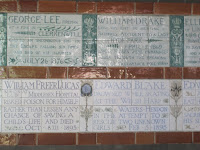






After worship we spent some time in the side chapel and heard a bit of history about the site from one of the volunteer guides. We got a couple of pictures of our group in here as well: of just the clergy and of the clergy with their spouses.

We also got the opportunity to tour the garden behind the church, where Wesley's grave is located.

Aldersgate Street where Wesley experienced his heartwarming conversion was not far away. Nearby is the London Museum and outside of it is a large monument to Wesley and Aldersgate. We also saw remains of an early Roman road and occupation nearby, exposed during the bombing of World War 2.
Charles Wesley also had his own conversion experience a few days before his brother's in this same general area. He was staying with friends while recuperating from an illness; a plaque above the door marks the spot.
Behind Aldersgate Street there is a park known as Postman's Park (near the old post office where the postman used to eat their lunch). There is a monument wall there to ordinary people who have given their lives in trying to save the lives of others.
On our way to see the national cathedral, St. Paul's, we stopped at the ruins of Christ Church, bombed out during the war. It was not rebuilt because at the time there was not a congregation worshipping here and there were many other churches nearby. Now the tower is a private apartment and the gardens belong to a cellphone company.
Before leaving London, we toured the outside of St. Paul's Cathedral. There was another statue of Wesley here - the only one in fact in the area surrounding the Cathedral, signifying his prominence in history. Nearby was a monument marking the beginning of the YMCA and also there was a public exhibit featuring pianos called "Play Me I'm Yours."
We left in time to have dinner back at Harris Manchester. It is an English tradition dating back to the time of King Edward VII to dine on roast beef and yorkshire pudding on Sundays. Ours was truly delicious!
Following dinner Elaine led our devotion, talking about the Methodist tradition of a love feast. We all ended up going with the Fannins walking around town - we saw the site in the road marking the spot where Bishops Ridley and Latimer were martyred back in 1555 and also saw Wesley Memorial Methodist Church. Our final tour stop was the spot where Wesley established his first Methodist meeting house in Oxford. Of course our evening ended up with another trip to the pub and more fellowship!




















































No comments:
Post a Comment